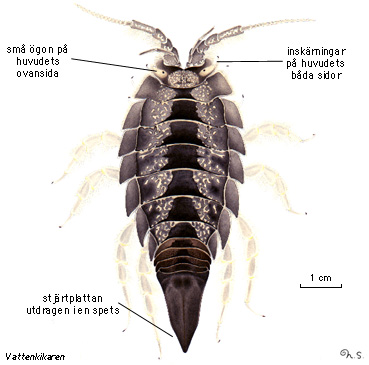|

Distribution in scandinavian waters
|
Maximum length: The male can be up to 8,6cm long, while the
female is somewhat shorter.
Appearance: The body has an oval shape with a length that is
roughly 2,5-3 times its width. The anal plate is drawn out to a point.
Has a grey-brown colour. In contrast to the Baltic
isopod, Saduria entomon has small eyes on top of the head
and notches on both sides.
Depth: From sea level and to a depth of 290m.
Environment: Saduria entomon lives on and in varying types
of bottoms, e.g. sand, gravel, mud and clay. It also has the ability
to swim upwards a bit.
Misc: Saduria entomon is a predator and eats amphipods
such as Monoporeia
affinis and mussels such as Baltic
macomas , aswell as freshwater lice and chironomidae larvae. It
also eats carrion and has been shown to be a cannibal, which eats other
individuals of the same species. Saduria itself is also preyed
upon by fish such as cod
and the short-horned sculpin. Because saduria is relatively stationary
and is senstive to lack of oxygen, it is used as an indicator of the
environmental state in the Gulf of Bothnia.
It is believed that saduria wandered into
the Baltic area from the Barents Sea for more than 7000 years ago at
the end of the last ice age. Because they are found in many places in
the Arctic, the population in the Baltic is known as an ice age relic.
Along the coast of Norrland, saduria causes
problems for fishermen as it attacks netted herring.
Classification: Saduria is a member of the lice group,
which is a crustacean under the arthropods.
|


